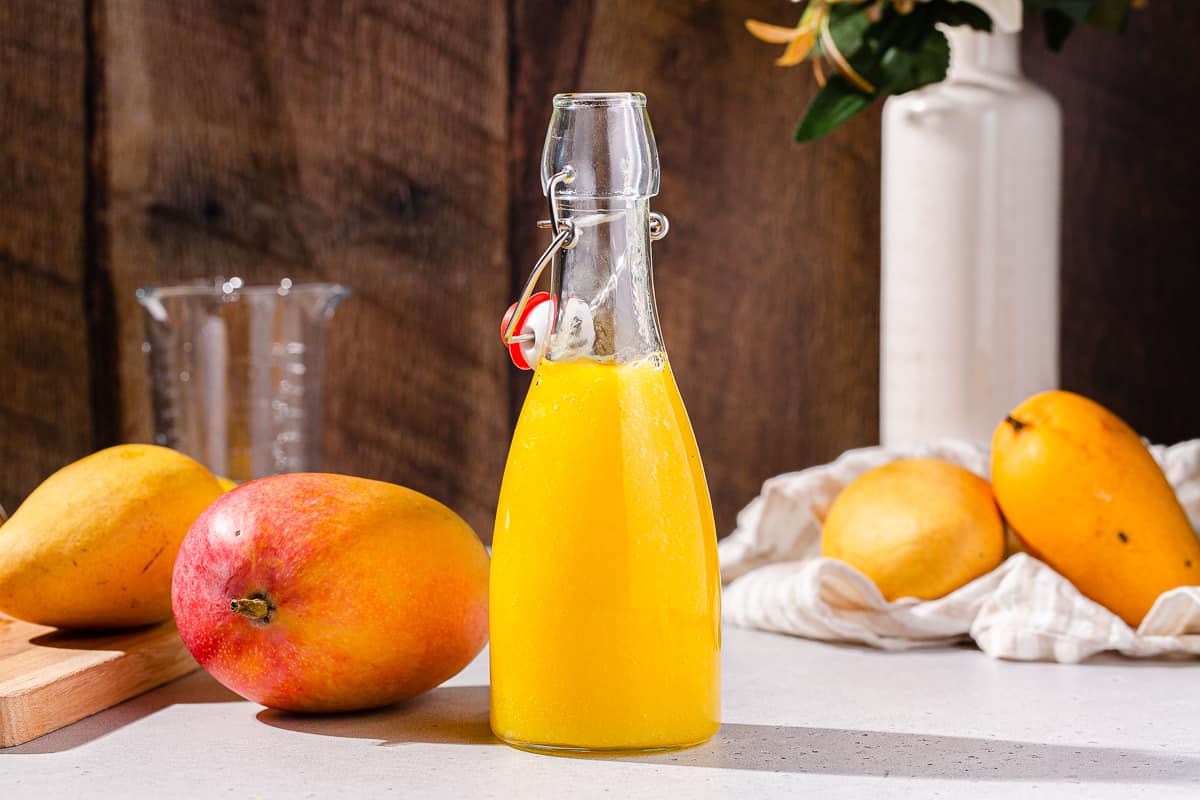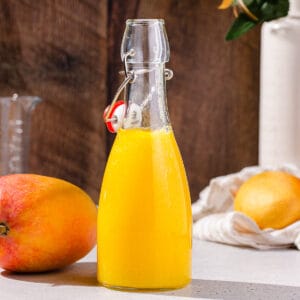Mango Nectar is a thick, rich and delicious way to incorporate fresh mangoes into your recipes. It's perfect for cocktails, mocktails, sweet sauces, and even for topping ice cream. It's easy to make, and wonderful to have on hand for tropical drinks in the summertime!

Mango Nectar is essentially a mango puree that has been sweetened and thinned out with simple syrup. This makes the puree more pourable and easy to use in cocktails.
Most of the time, when I make simple syrup, I will heat up the sugar and water mixture. In this recipe, there is not really a need to do that. The benefits of heating and killing bacteria are pretty much negated by adding it to puree, since the puree will spoil much faster than the syrup.
Once you have your mango nectar made, give this Mango Mai Tai recipe a try! Or, add it to a soda or seltzer for a bubbly mango mocktail.
Looking for more make-at-home sweeteners and flavored syrups? Check out my easy Hibiscus Syrup recipe, or my Caramel Syrup recipe. You can read more about making plain cocktail syrup in my post on How to make Simple Syrup.
Ingredients
You'll only need three ingredients to make this recipe (two if you already have simple syrup in your fridge!)
- Water - preferably filtered or bottled water for the best taste.
- Sugar - use white granulated sugar here, unless you prefer a little bit of warm flavor from cane sugar or another type of less processed sugar.
- Fresh Mango - look for a ripe mango that is soft, but doesn't have a wrinkled skin. The fruit should smell like mango from the outside of the skin.

What Type of Mango to Use
There are several types of mangoes, but the best types for this recipe are either Ataulfo mangoes (also known as Champagne mangoes), Alfonso mangoes, or red mangoes.
Ataulfo and Alfonso mangoes are similar. They have a delicious honey-like flavor and a less fibrous texture to the flesh. Red mangoes are also very flavorful, but with a little more fiber to the flesh.
The most important thing is that your mango is ripe and ready to use. The flesh should be soft, the skin should be smooth and unwrinkled, and the fruit should smell like mango from the outside of the skin.

Substitutions
If you don't have any fresh mangoes available, you can use frozen mango chunks instead.
If you would like to substitute out the simple syrup in this recipe, there are a few options:
- Sugar Substitute - instead of sugar in your simple syrup, you can use an alternative sweetener like allulose. This will give the final nectar a similar richness, but with much less sugar. See the Low Calorie Keto-Friendly Simple Syrup section of my simple syrup how-to article.
- Maple Syrup - using maple syrup in place of the simple syrup will give a little bit of maple flavor to the finished nectar. The mango will still be the main flavor.
- Water - instead of thinning out the nectar with simple syrup, use water instead. You can use a half cup of water in place of the ¾ cup of syrup. The puree will still be sweet from the sugar in the mango itself, but not nearly as sweet. It will still be more pourable than a plain puree.
- Mango juice - in order to get the maximum mango flavor, you can substitute mango juice in for the simple syrup.

Equipment
The main equipment you'll need to make this recipe is a blender. You can use a large blender or a personal sized blender. If you can't access a blender, you can purchase mango puree and then just mix it with simple syrup (but in that case, you might as well just buy the mango nectar itself!)
You'll also want to have a funnel and some kind of resealable bottle to hold the finished nectar. I really love these 12 ounce swing-top bottles, since they are the perfect size to hold one recipe.
Instructions
If you don't have simple syrup on hand already, you can make a quick simple syrup using sugar and water in your blender. Start out by adding your dry sugar to the blender and pulse until it is a finer texture. (You can skip this step if you are using caster sugar.)
Then, add in the water, seal up the blender and pulse the sugar and water mixture. Keep blending in 10 second bursts until it looks like the sugar has dissolved.


Pour the simple syrup into a separate container and set aside.
Then, cut up your mango. I've found the best way to cut a mango is to use a long knife, and make cuts on either side of the pit. A mango pit is kind of flat, like a big pumpkin seed, so you want to cut along the flat sides of the pit.
Use a spoon to scoop out the mango flesh. Try to keep the bowl of the spoon close to the skin so you get as much of the flesh out as you can. Then, cut the mango flesh into cubes and add it to your blender.


Pulse the blender to break up the chunks, and then blend in 10 second intervals until the fruit is completely smooth and pureed.
Then, add the simple syrup back to the blender. Seal it up and do a few more 10 second blending intervals until it is all mixed together.


Take the container you're planning to store the nectar in and add a funnel to the top. Carefully pour the finished nectar through the funnel and into your storage container.
You can use it right away, or store it in an airtight container in the fridge for up to a week.


Frequently Asked Questions
Although they both use fresh mangoes, mango nectar and juice are not the same. Mango nectar is pureed mango mixed with a sugar syrup. Mango juice is the liquid left when all of the solids and fibers have been taken out of a mango puree. The nectar is thick and opaque. The juice is much thinner and you can see through it.
No, mango nectar and mango syrup are not the same. Mango nectar is a mixture of pureed mango and simple syrup. Mango syrup, though, is made by flavoring simple syrup with mango, and doesn't have mango fibers in it. You can do this by letting mango pits sit in sugar overnight and draining out the resulting syrup (this method is called maceration.) Or, you could add cut up mango to hot simple syrup on a stovetop. After the mango cooks a little, strain the mango chunks out to get a clear syrup.
Top tip
Mango nectar can be stored in the freezer for several months. If you pour your finished nectar into ice cube trays, you can freeze it until it's solid. Then take the cubes out, and store them in an airtight bag or other container. Note that the cubes will be a little bit sticky, and not as hard as plain ice.
Alternatively, you can freeze just the mango puree without adding the syrup. The cubes will freeze a little bit better, and you can just defrost and mix them with simple syrup instead of using frozen mango chunks.
📖 Recipe

Mango Nectar
Ingredients
Simple Syrup - enough to make ¾ cup syrup
- ½ cup sugar (use caster or superfine sugar if possible)
- ½ cup water
Mango Puree
- 1 mango (preferably 1 large Ataulfo mango - enough for 1 cup of chunks - or use 1 cup of frozen mango chunks)
Instructions
Simple Syrup
- Add the sugar to your blender. If you are not using caster or superfine sugar, pulse blend the dry sugar into more of a powder to make it easier to dissolve.
- Add the water into the blender and pulse to mix. When the sugar looks like it has dissolved, you can pour the simple syrup into another container and set it aside.
Mango Puree and Nectar (Fresh Mango)
- If you are using fresh mango, cut up your mango into chunks until you have about a cup of mango chunks. Add the chunks into your blender and pulse to puree.
- Add ¾ cup of the simple syrup in with the mango puree and reseal the blender. Pulse blend until everything is mixed and smooth.
Mango Puree and Nectar (Frozen Mango)
- If you are using frozen mango chunks, don't try to blend them by themselves. Add in ¾ cup simple syrup along with the mango chunks, and pulse to blend until smooth.
Storage
- Using a funnel, pour the finished nectar into a resealable container, like a swing-top bottle. You can store it in the refrigerator for up to a week, or freeze it into cubes.



Comments
No Comments